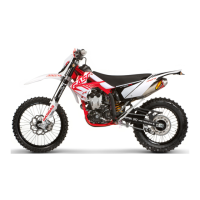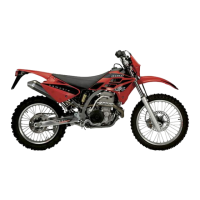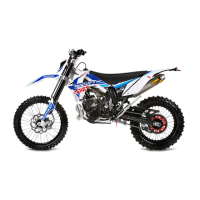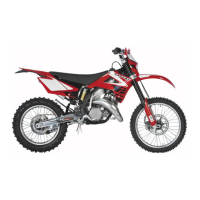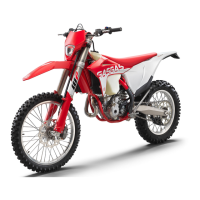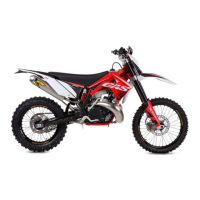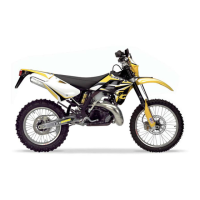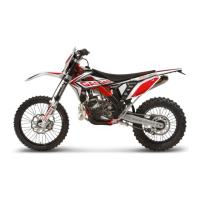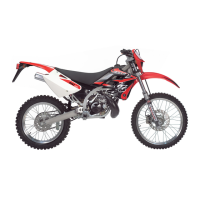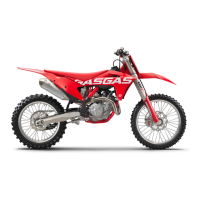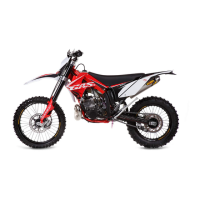Do you have a question about the GAS GAS FSE 450 and is the answer not in the manual?
Details important notices, warnings, cautions, and notes for safe operation and understanding of the manual.
Provides detailed specifications for the engine, including displacement, bore, stroke, and spark plug type.
Outlines transmission type, gear ratios, clutch, and chassis construction, including tyre sizes.
Details suspension components, stroke, brake type, and effective disk diameter.
Lists the overall height, length, width, wheelbase, ground clearance, and weight.
Identifies key controls on the handlebars for FSE and FSE SM models.
Illustrates and labels major components of the motorcycle.
Instructions for using the side stand.
Details on recommended fuel and tank capacity.
Specifies fuel octane requirements.
Locations for serial and approval plates.
Step-by-step procedures for starting and stopping the motorcycle's engine.
Guidance on starting a cold engine.
Instructions for performing gear changes.
Procedure for safely stopping the motorcycle using throttle and brakes.
Detailed steps for the initial break-in period to ensure engine and transmission longevity.
Comprehensive chart outlining required maintenance tasks at different service intervals.
Steps for safely removing and reinstalling the motorcycle battery.
Guidelines for charging the battery using constant voltage or power modes.
Instructions for inspecting radiator hoses for cracks and radiator fins for obstructions.
Explains the function of coolant, anti-freeze, and precautions for handling.
Detailed steps for checking the coolant level safely, including radiator cap removal.
Step-by-step guide for draining, replacing, and refilling the motorcycle's coolant.
Guidance on inspecting, cleaning, gap adjustment, and replacing spark plugs.
A table correlating spark plug types with maintenance recommendations.
Detailed steps for removing the spark plug and cleaning carbon deposits.
Explains the importance of the air filter and potential hazards of a clogged filter.
Instructions and precautions for cleaning the air filter.
Detailed steps for cleaning and installing the air filter.
Procedure for adjusting throttle cable play for smooth operation.
Steps to adjust the clutch lever play for optimal engagement.
What to do if the clutch lever adjustment is at its limit.
Information on the exhaust system and silencer maintenance.
Inspecting the chain guide and adjusting chain tension for proper function.
Guidance on lubricating the chain and inspecting for wear.
Instructions on how to adjust the handlebar position for rider comfort.
Torque specifications for handlebar mounting bolts.
Adjusting front brake lever and rear brake pedal play.
Procedures for checking brake fluid level, changing fluid, and inspecting pad wear.
How to check and adjust steering for proper operation and minimal play.
Instructions on how to use the steering lock mechanism.
Factors influencing front fork adjustment, including rider weight and conditions.
How to adjust the front fork's rebound damping.
How to adjust the front fork's compression damping.
Procedure for adjusting the oil level in the front forks.
Information on recommended fork springs and oil types.
Steps for installing the suspension spring and related components.
How to adjust the rebound damping of the rear shock absorber.
How to adjust the compression damping of the rear shock absorber.
Procedure for adjusting the rear shock absorber spring preload.
Adjusting tyre pressure based on track conditions and rider preference.
Instructions for checking spoke tension and rim centering.
Steps to prepare the motorcycle for cleaning and areas to protect from water.
Steps to follow after cleaning, including lubrication and brake checks.
Importance of ensuring all bolts and nuts are tightened daily.
Diagram illustrating key points for checking bolt tightness.
A table listing specific torque values for various bolts and nuts.
Identifies key points for general lubrication with oil or grease.
Guidance on lubricating the drive chain, including oil viscosity.
Details on recommended engine oil types, viscosity, and API classification.
Procedure for checking the engine oil level accurately.
Steps for changing the engine oil and filter.
Specific instructions for replacing the engine oil filter element.
General advice and factors to consider when tuning suspension.
Specific adjustments for front forks, including rebound, compression, and oil levels.
Common front fork issues and their solutions.
Common rear shock absorber issues and their solutions.
Advice based on rider experience and checking front/rear suspension balance.
Adjustments for handling issues in turns and during jumps.
Guidance on selecting appropriate gear ratios based on track conditions.
Information on obtaining spare parts and special care for different track conditions.
Lists of checks required before and after competition riding.
Specific maintenance tasks after racing on dusty or muddy terrain.
Procedures for preparing the motorcycle for storage and taking it back into use.
Explanation of the multifunction display, its modes, and settings.
How to set and reset trip distance and adjust the clock.
Diagnosing and resolving problems with the starter motor and engine rotation.
Troubleshooting common issues related to engine starting and smooth running.
Diagnosing and fixing problems with engine performance and overheating.
Addressing abnormal engine noise, exhaust fumes, and gear engagement problems.
Troubleshooting clutch slipping, bike instability, and shock absorption problems.
Resolving issues with handling, vibrations, noise, and brake system malfunctions.
Diagnosing and fixing problems with the motorcycle's lighting system.
Provides a comprehensive diagram of the motorcycle's electrical system.
Explains the meaning of different wire colors used in the schematics.
Details the manufacturer's warranty terms, coverage, and duration.
Outlines the purchaser's responsibilities and items excluded from warranty coverage.
| Compression Ratio | 12.5:1 |
|---|---|
| Transmission | 5-speed |
| Category | Enduro |
| Displacement | 449 cm3 |
| Cooling System | Liquid-cooled |
| Fuel System | Electronic Injection |
| Rear Suspension | Monoshock |
| Front Brake | Single disc |
| Rear Brake | Single disc |
| Engine Type | Single cylinder, 4-stroke |
